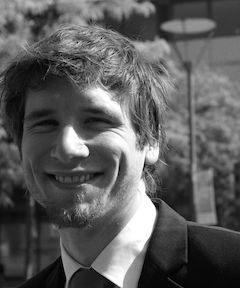In October, the Aachen Graphene & 2D Materials Center has gained a new member: Prof. Dante Kennes, professor for Theoretical Condensed Matter Physics at RWTH Aachen University and visiting scientist at the Max Planck Institute for the Structure and Dynamics of Matter in Hamburg.
Kennes, is an expert in many-body quantum systems and in the development of theoretical methods for investigating the properties of strongly correlated systems out of equilibrium. Two-dimensional materials play a major role in his research interests, as they offer a rich playground where to search for new correlation effects and exotic phenomena.

“I’m fascinated by the idea of developing Quantum Matter on Demand”, says Kennes, “that is, by the possibility of programming and controlling quantum properties at will. The ultimate goal of my research is to provide guiding principles motivated by theory on how to realize Quantum Matter on Demand and on howto use it in practice. Artificial van der Waals heterostructures are ideal for this scope, because they offer an unusual wealth of knobs with which we can modify their properties”.
One of these knobs is the twist angle. Indeed, when 2D materials are stacked on top of each other to form an artificial van der Waals heterostructure, the properties of the latter strongly depend on the angle between the different crystal lattices. “The most famous example of this phenomena is the emergence of superconductivity in “magic-angle” twisted bi-layer graphene”, says Kennes, “but the field of twistronics is still almost virgin and I’m sure there are still many surprises ahead of us. For instance, twistronics might allow to realize Kagome lattices and to find ways to tune magnetic interactions in a controlled manner”.
Twisted van der Waals heterostructures are at the focus of the research project pursued by Kennes within the SPP 2244 “2D Materials – Physics of van der Waals [hetero]structures”, where he is going to employ both effective few-bands models and methods that take into account the entire moiré Brillouin zone to determine the phase diagram of twisted heterostructures, as well as their relevant energy scales, their response functions, and information on the tuning possibilities.
The twist angle is not the only knob at hand to tune correlated phenomena in twisted van der Waals materials. The relatively low energy scales of these systems suggest that it might be possible to steer emergent phenomena such as magnetism and superconductivity by driving the systems with relatively weak light fields (Floquet engineering) or by coupling them to a cavity photon mode (cavitronics). These are two other research directions explored by Kennes, which well match his long-standing interest and expertize in the physics of non-equilibrium systems. “The field of twistronics is literally booming”, says Prof. Christoph Stampfer, spokesperson of the Aachen Graphene & 2D Materials Center. “Since the discovery of superconductivity in twisted bi-layer graphene in 2018, there has been a huge rise of experimental and theoretical activities aimed at exploring the possibilities offered by twisted van der Waals heterostructures, which makes this an extremely dynamic and exciting, but also competitive field. It is great for the Center to win with Dante Kennes top-notch expertize in this area.”
